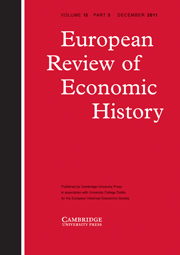Article contents
Explaining the industrial transition: a non-Malthusian perspective
Published online by Cambridge University Press: 01 August 2008
Extract
The large-scale structure of world economic history exhibits three steady states punctuated by two phase transitions. The first transition arrived with the domestication of plants and animals; the second with the invention of engines capable of converting thermal to mechanical energy for applications in mining, manufacturing, and transportation. Yet, although both transitions led to increases in the absolute size of the economy, they affected the standard of living differently. Whereas the Industrial Revolution resulted in sustained growth in real per capita income for more than two centuries, over nine millennia the Agricultural Revolution spent itself in population growth that left per capita income insignificantly higher, and possibly lower than the level prevailing under hunting and gathering. This pattern raises three fundamental questions in economic history: why did the first great technological transition produce secular stasis in living standards? Why has the second yielded both steady growth in population and rising living standards? What triggered the transition from the stationary agricultural state to the progressive industrial state?
- Type
- Research Article
- Information
- Copyright
- Copyright © Cambridge University Press 2008
References
- 11
- Cited by


